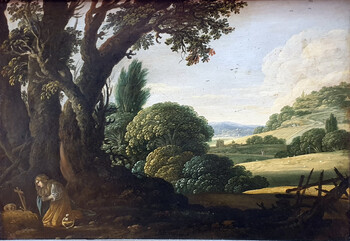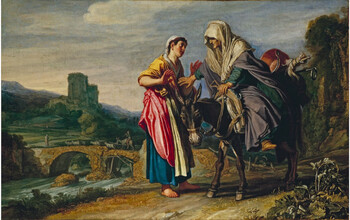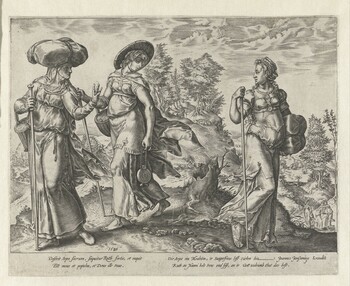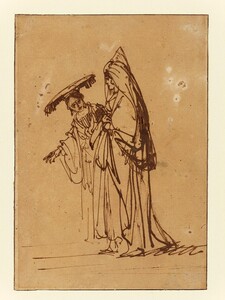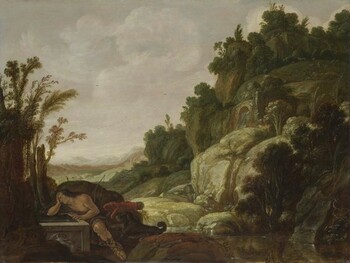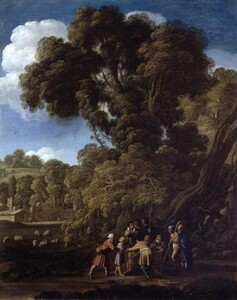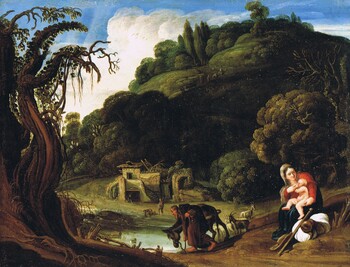12.500 €
The Biblical story of Ruth and Naomi (Ruth 1:11-16)
Oil on panel : 68,9 X 93,4 cm
Signed bottom right “J….P..as”
Frame : 91,8 X 115,3 cm
Our painting is recorded at the RKD, The Hague, Number 0000344673
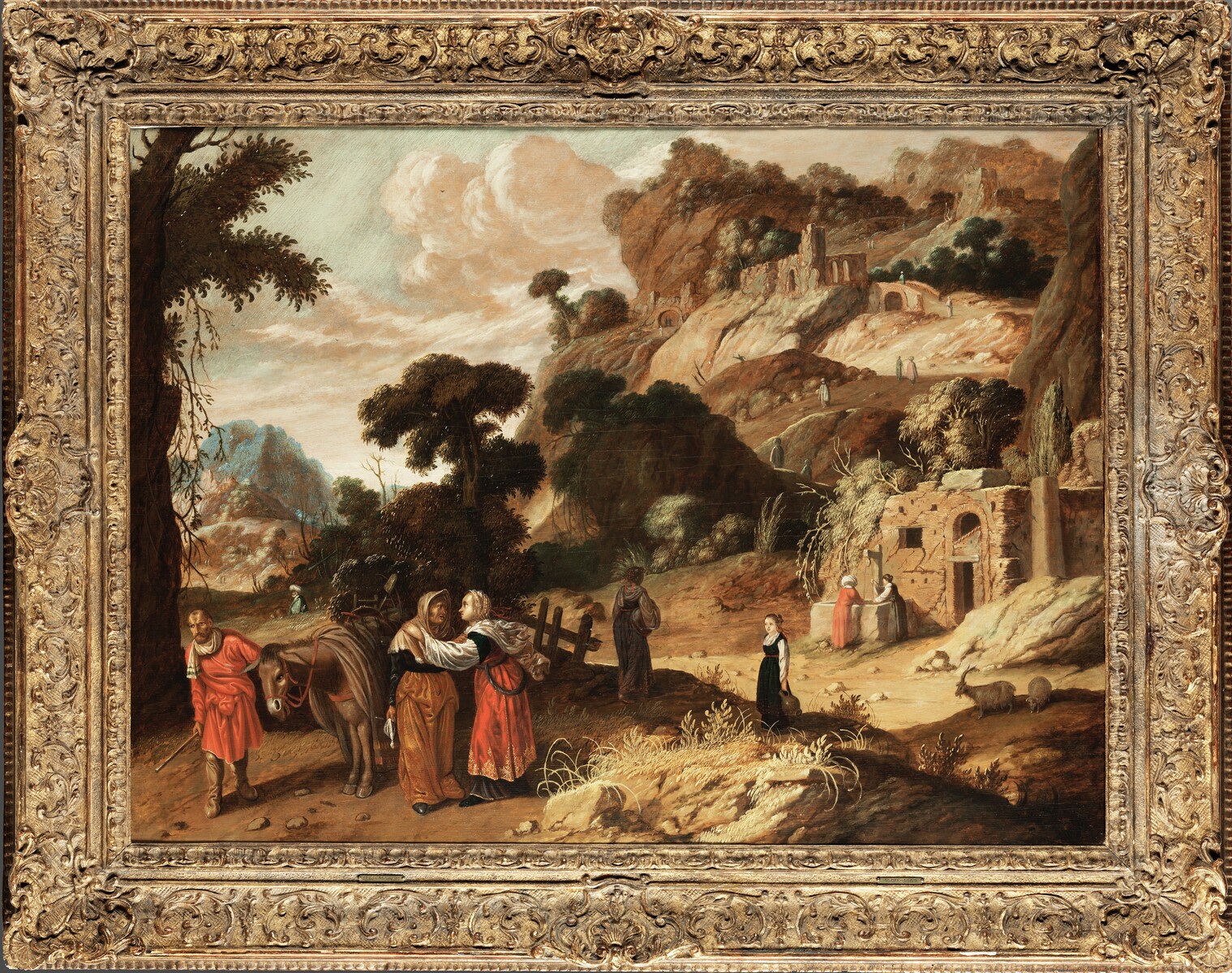
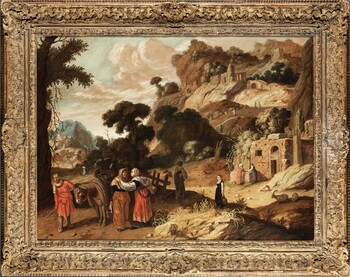
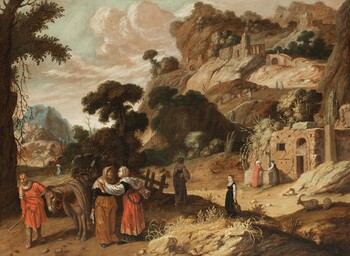
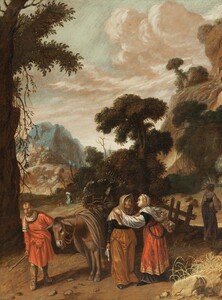
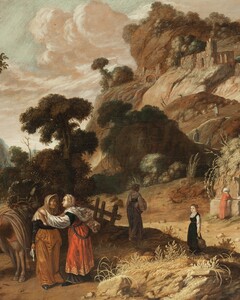
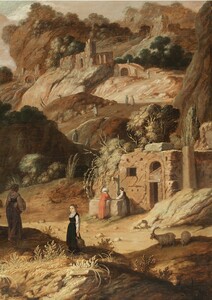
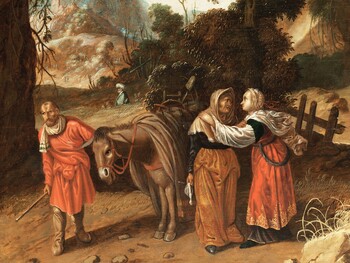
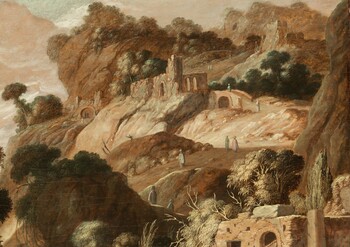
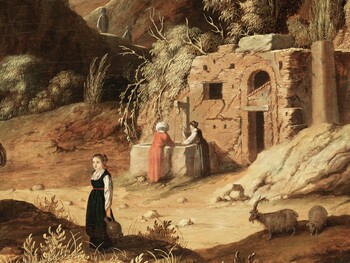
In short
Jacob Pynas is one of the so-called Pre-Rembrandt History Painters: early 17th century Dutch painters of Biblical and mythological subjects who had an important influence on Rembrandt in his early years.
Our painting represents a Biblical scene from the Old Testament: a foreign woman, Ruth, remains faithful to her mother-in-law, Naomi, and to her new, Jewish religion. Ruth is an ancestor of King David and therefore also of Jesus Christ.
About Jacob Symonsz. Pynas
Dutch painter
Amsterdam or Haarlem 1592/93 – after 1650 Delft?
Painter of biblical subjects set in a landscape.
Younger brother and pupil of the painter Jan Pynas (Alkmaar 1581/82 – 1631 Amsterdam). Their father, Symon Brouwer, was born in Alkmaar, but settled in Amsterdam. He was a dealer in salt who had a signboard at his house on the Nieuwendijk of a pinnace, a vessel used to transport salt (especially from Portugal), hence his surname “Pynas”. It is thought that Symon Brouwer belonged to the Mennonite Church, where baptism is reserved for adults only.
Our Jacob Pynas must circa 1605 have been too young to have travelled with his ten years older brother, Jan, and with Pieter Lastman to Rome, where they stayed for two years. Several sources still mention this journey, although Jacob was at their departure just 12 or 13 years old.
All three, Lastman, Jan and Jacob Pynas were influenced by Jacopo Tintoretto and by Adam Elsheimer, the Pynas brothers, in particular by the Venetian painter Carlo Saraceni, who had himself fallen under the Elsheimer spell a year or two earlier. In the lickely event that our Jacob Pynas did not participate in this Roman voyage he must have picked up these influences through his brother and though Lastman, in whose Amsterdam workshop in the Saint Anthonisbreestreet both brothers must have been active. It still remains plausible that Jacob Pynas travelled at a later date (with his elder brother Jan) to Rome.
The Pynas brothers, Jan Tengnagel (who married in 1611 with their sister Meynsjen), Claes Cornelisz. Moeyaert and Pieter Lastman are considered the most important Dutch history painters, prior to arrival of Rembrandt in 1631 in Amsterdam. They are therefore called the “Pre-Rembrandt” school of history painters. They specialised in subjects from the Old and the New Testament and in mythological subjects. Their post-Mannerist landscapes were strongly influenced by Adam Elsheimer.
After his return from Italy Jacob’s elder brother, Jan, lived in Amsterdam. Typical of Jan is his inclination towards simplicity, the reduction of narrative devices and the depiction of his protagonists in profile.
As to our Jacob Pynas he never got married and lived in different Dutch towns; he is documented in Amsterdam in 1608 and in 1641- 43, in The Hague in 1622, in Leiden before1626 and in Delft between 1631 and 1639. He is the only Pre-Rembrandtist painter to have worked in two different compositional styles : pictures with figures so small they seem like mere staffage (standing close to Elsheimer) and later pictures with relatively large figures. Because he influenced the young Rembrandt through the use of a warm, unified brown tone earlier scholars thought Rembrandt had been for a short while his pupil, after he left the workshop of Pieter Lastman. But except for the not always trustful Arnold Houbraken (1680 – 1719) there are no other written sources confirming this. On the other hand there is the clear influence, stylistic and in the choice of this subject, of Jacob Pynas on Rembrandt’s earliest painting known, The Lapidation of Saint Stephan.
About the subject of our painting
The Biblical Story of Naomi and Ruth is a symbol of abiding loyalty and devotion. At the end God rewards a foreign woman who attaches herself to the values of Judaism.
At a time of great famine in Bethlehem a man fled with his wife Naomi and their two sons from Judea to settle in Moab (present-day Jordan). After her husband passed away, both sons of Naomi married native women, Orpah and Ruth. After both her sons have died Naomi decided to return to Israel, to Bethlehem and she asked her daughters-in-law to return to their local families.
Orpah does so, but Ruth refuses to leave Naomi, declaring (Ruth 1:16 –17), “Where you go, I will go; where you lodge, I will lodge; your people shall be my people, and your God my God. Where you die, I will die —there will I be buried.” Ruth accompanies Naomi to Bethlehem and later marries Boaz, a distant relative of her late father-in-law. Their grandson will be the father of (King) David, whose genealogy would come to Joseph and thus to Jesus Christ.
About our painting
In 1614 Pieter Lastman had been the first to represent this subject in Dutch painting. Hendrick Goltzius had already represented it in an engraving in 1580. Lastman was the first to include the donkey as an narrative element, which Jacob Pynas has taken over from him here.
At left we see Ruth pleading with Naomi that she will follow her. Behind Ruth, at the centre of the composition, Orpah returns to her family. The rocky landscape represents the Land of Moab (Jordan).
Why should you buy this painting?
Because this beautiful composition forms an important link between Pieter Lastman and Rembrandt.

